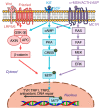Natural skin-whitening compounds for the treatment of melanogenesis (Review)
- PMID: 32509007
- PMCID: PMC7271691
- DOI: 10.3892/etm.2020.8687
Natural skin-whitening compounds for the treatment of melanogenesis (Review)
Abstract
Melanogenesis is the process for the production of melanin, which is the primary cause of human skin pigmentation. Skin-whitening agents are commercially available for those who wish to have a lighter skin complexions. To date, although numerous natural compounds have been proposed to alleviate hyperpigmentation, insufficient attention has been focused on potential natural skin-whitening agents and their mechanism of action from the perspective of compound classification. In the present article, the synthetic process of melanogenesis and associated core signaling pathways are summarized. An overview of the list of natural skin-lightening agents, along with their compound classifications, is also presented, where their efficacy based on their respective mechanisms of action on melanogenesis is discussed.
Keywords: melanogenesis; natural sources; skin-whitening agents; tyrosinase.
Copyright: © Qian et al.
Figures



Similar articles
-
Potential application of natural bioactive compounds as skin-whitening agents: A review.J Cosmet Dermatol. 2022 Dec;21(12):6669-6687. doi: 10.1111/jocd.15437. Epub 2022 Nov 7. J Cosmet Dermatol. 2022. PMID: 36204978 Review.
-
The melanogenesis and mechanisms of skin-lightening agents--existing and new approaches.Int J Cosmet Sci. 2011 Jun;33(3):210-21. doi: 10.1111/j.1468-2494.2010.00616.x. Epub 2011 Jan 25. Int J Cosmet Sci. 2011. PMID: 21265866 Review.
-
Recent development of signaling pathways inhibitors of melanogenesis.Cell Signal. 2017 Dec;40:99-115. doi: 10.1016/j.cellsig.2017.09.004. Epub 2017 Sep 12. Cell Signal. 2017. PMID: 28911859 Review.
-
Tranexamic acid inhibits melanogenesis by activating the autophagy system in cultured melanoma cells.J Dermatol Sci. 2017 Oct;88(1):96-102. doi: 10.1016/j.jdermsci.2017.05.019. Epub 2017 Jun 7. J Dermatol Sci. 2017. PMID: 28669590
-
Natural and synthetic flavonoid derivatives as new potential tyrosinase inhibitors: a systematic review.RSC Adv. 2021 Jun 23;11(36):22159-22198. doi: 10.1039/d1ra03196a. eCollection 2021 Jun 21. RSC Adv. 2021. PMID: 35480807 Free PMC article. Review.
Cited by
-
Potential Cosmetic Active Ingredients Derived from Marine By-Products.Mar Drugs. 2022 Nov 24;20(12):734. doi: 10.3390/md20120734. Mar Drugs. 2022. PMID: 36547881 Free PMC article. Review.
-
Neurog1-Derived Peptides RMNE1 and DualPep-Shine Penetrate the Skin and Inhibit Melanin Synthesis by Regulating MITF Transcription.Int J Mol Sci. 2023 Mar 24;24(7):6158. doi: 10.3390/ijms24076158. Int J Mol Sci. 2023. PMID: 37047130 Free PMC article.
-
Development of Pigmentation-Regulating Agents by Drug Repositioning.Int J Mol Sci. 2021 Apr 9;22(8):3894. doi: 10.3390/ijms22083894. Int J Mol Sci. 2021. PMID: 33918792 Free PMC article. Review.
-
Chemical Composition and Skin-Whitening Activities of Siegesbeckia glabrescens Makino Flower Absolute in Melanocytes.Plants (Basel). 2023 Nov 22;12(23):3930. doi: 10.3390/plants12233930. Plants (Basel). 2023. PMID: 38068567 Free PMC article.
-
A Network of MicroRNAs and mRNAs Involved in Melanosome Maturation and Trafficking Defines the Lower Response of Pigmentable Melanoma Cells to Targeted Therapy.Cancers (Basel). 2023 Jan 31;15(3):894. doi: 10.3390/cancers15030894. Cancers (Basel). 2023. PMID: 36765859 Free PMC article.
References
LinkOut - more resources
Full Text Sources
